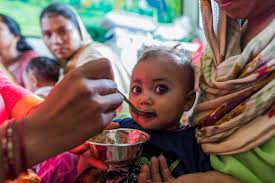
A threat to food security
A threat to food security
S. GURUMURTHY
The National Food Security Bill, a high risk venture of UPA government, is more a product of soft politics than hard economics. The Bill promises to supply, at subsidised prices, 7 kg of foodgrains to each Indian, every month, at 1/8th of the economic cost of grains in the first year, ending up at 1/9th of the economic cost in the third year.
It aims to envelop two-thirds of the population. Its huge reach measures its vote-bank potential. Finding itself in Catch-22 situation, the opposition would hate the ruling party to succeed in garnering votes through the scheme but, would not oppose it as that would be politically suicidal. With the entire political spectrum backing the Bill, the public discourse on the Bill is mute, if not muffled. What the nation is not conscious of is that, because of the lack of rigorous intellectual scrutiny, the Bill threatens the food security of the whole country --- even as it seeks to address the food security of two thirds of its people.
The national debate has so far touched two aspects of the Bill. One, its impact on the Budget. The elephantine scheme would torpedo government's plans to make the future budget deficits Kelkar Report- compliant. It looks unaffordable even at the optimistic growth targets of economy.
The additional dent it will cause in the first budget after its advent is likely to be twenty times the effective extra provision of Rs 5,000 crore made in the Budget for 2013-14, if the Bill is passed in the current Budget session (See Food Bill will torpedo Budget, Business Line, March 21, 2013).
MORE FARM OUTPUT
The second aspect of the discourse is operationally more critical. The Discussion Paper of the Commission on Agricultural Costs and Prices (CACP) titled “National Food Security Bill Challenges and Options” says that, on a procurement-production ratio of 35 per cent, the current production of rice and wheat (of 190 million tonnes) would yield 67 million tonnes of stocks.
The scheme requires 75 million tonnes. So, a further 8 million tonnes need to be procured. As much of the additional production and procurement will have to be dispersed outside Punjab and Haryana, the procurement ratio will be less at 30 per cent and so national grain production has to rise by 25 million tonnes to achieve the additional 8 million tonne procurement.
So the second aspect of the debate is about how to increase food production by 25 million tonnes to work the scheme. And, how to procure 75 million tonnes, and for that, how build the logistics – storage, transport, and handling. The first part of the discourse seems to assume the second part as a done deal and the second part seems to assume the first part as done, when neither is done.
SMALL FARMERS’ IMPACT
What is as yet not seen in the radar of discourse is the impact of the Food Bill on Indian farming. Particularly on small farmers. And, on the village and agricultural economy which is substantially backward- integrated to the small farmers’ kitchen and also the kitchen of most landless labour.
The government intends to procure 75 million tonnes to supply food grains to some 750-800 million people – two thirds of the population. The first question is: from whom will the government procure the supplies and to whom does it intend to supply?
What is shocking is that most of the persons in rural areas to whom the government will supply grains at highly subsidised rates under the scheme are the very small and marginal farmers from whom it will have to procure the supplies! See how this crazy agro-economics works.
According to Census 2011, the urban Indian population is 377 million and the rural, 743 million. Like the two thirds of urban population (251 million), two-thirds of the rural population (495 million) will also benefit under the scheme. Now, look at the structure of the beneficiaries in the rural population. Out of some 138 million farm households, 117 million are small and marginal farmers owning less than 2 hectares (State of Agriculture Report 2012-13).
The average farm family size being five, some 690 million people live on 138 million farms. About a third of the landless rural households with a population of 75 million cultivate as tenants, leaving some 50 million as totally landless labour. After accounting the entire 75 million landless as beneficiaries under the scheme, the balance 420 million beneficiaries will be from the small and marginal farming family.
These small and marginal farmers who produce substantial foodgrains, also consume and use a large part of what they produce. Generally, all farmers consume and use a large part of what they produce.
TRADITIONAL SYSTEM
According to the Working Group on Agricultural Marketing Infrastructure and Policy Required for Internal and External trade (Eleventh Plan) out of the total foodgrains produced, farm families consume and use 60 per cent for their needs and sell only 40 per cent – called the marketable surplus. But, small and marginal farmers retain more than 60 per cent for personal use and for market they set aside less than 40 per cent.
Here are some details for urbanites to understand why and how the farmers use up 60 per cent of their produce. Apart for their family consumption, which is in excess of a third of their production, they retain the produce for paying permanent and temporary farm labour in kind; for feeding farm animals and as seeds; for payment in kind for farm equipments, customary dues, repayment of loan and irrigation charges. Thus, small and marginal farmer ends up largely feeding the farming family and paying in kind to the landlord and landless alike in kind, which distributes the foodgrain within the village.
So, 60 per cent of the grain produced is shared within the village for farm families’ own consumption and by way of traditional barter which makes grain available to those, including labour, who do not own any land or cultivate.
This is how the food security of the villages is traditionally secured outside the modern market system. Only the balance produce moves into urban India and into trade within and outside India.
FOOD BILL EFFECT
Now, let us see how the national food security scheme adversely impacts on the traditional food security system at work.
The 117 million small and marginal farm families with population of 585 millions, constitute almost 78 per cent of the rural population. They now produce food for themselves, and also for others. They produce food more efficiently than medium and large farmers. While their families consume most of the foodgrains they produce, they also contribute a significant part of the national kitty of food production for others. If they stop producing foodgrains, the national kitty of food production will go down significantly.
Now under the Food Security Bill, most of their families will qualify for subsidised food grains. And they will get grain supply at less than 1/8 of the price at which they produce and sell grains to the government. If the government would supply them grain at 1/8 price, why should they till and toil on their land and produce 51 per cent of national food using 46 per cent of the cultivated area, particularly when their cost of cultivation per acre as compared to medium and large players is higher (http://www.igidr.ac.in/pdf/publication/WP-2012-014.pdf)
Rice and wheat cultivation is the most difficult and least gainful farm operation which is already haunted by shortage of labour and skyrocketing wage and input costs. Giving highly subsidised foodgrains to small and marginal farmers is the best way to dissuade them from farming for their family's food supplies.
PRODUCE MORE
How then to help the small and marginal farmers? According to the FAO the small and marginal farmers supplied as much as 7.2 million tonnes of food grains to the national grain market as early as in 1990. Another FAO publication titled, Smallholder farmers in India: Food security and agricultural policy (March 2002) concluded: “India’s agricultural economy and food security depend vitally on the small-holder farmers...It is socially beneficial to the nation that the number of small-holdings should continue to increase. It is therefore incumbent upon the nation to assist the small-holder families to increase their productivity and to augment their assets and entitlements.”
Assisting them means to make them produce more and not less, by incentivising their production and productivity by direct cash subsidies. The Food Bill is bound to encourage the small and marginal farmers to go for easy alternatives like commercial crops and horticulture.
Most States are deficient in food production. If in those States small and marginal farmers shift away from foodgrains, the country will face huge dent in food security.
That is precisely what the Food Security Bill is likely to end up achieving by large scale state intervention that threatens to disincentivise and turn some 700 million producers of food into consumers of food-dependent government supplies at subsidised rates. Will the nation wake up before it is too late?
(The author is National co-convener SJM and a well known commentator on political and economic affairs, and a corporate adviser.)
This article was published on May 2, 2013 in the Business line


